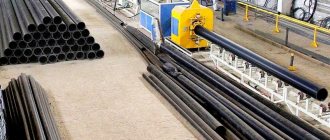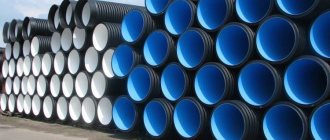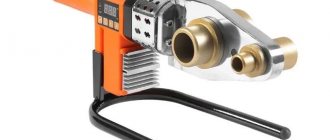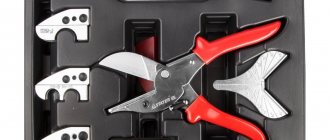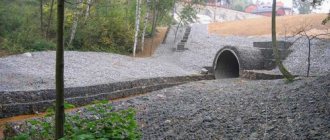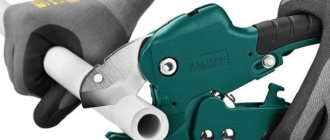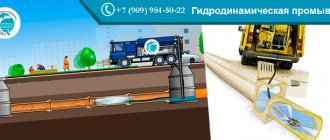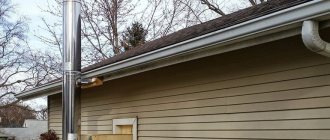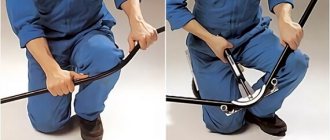A mandrel pipe bender allows you to create a stressed state of all-round uneven compression in the zone of plastic deformation of the workpiece. As a result, the plasticity of the material increases and the roughness of the walls of the product decreases, which, in turn, reduces the hydraulic resistance to the movement of the working environment in it. At the same time, the usual external defects of spatial pipe bending using conventional technology are prevented - corrugation, distortion of the profile at the bending site, thinning of the walls, etc.
A pipe bending machine works like this. The workpiece to be bent is installed in the matrix profile corresponding to the outer diameter of the product, and is pressed with a movable adjustable clamp. A steel rod is inserted inside with a mandrel rigidly fixed to it - a mandrel made of tool steel, equipped with a cone-shaped lead-in part, and having several support rings. They can be hinged to each other, giving the tool the ability to change its axis when bending the product at a given angle. In addition, each subsequent mandrel serves as a calibrating element, reducing the roughness of the hole of the workpiece.
The principle of operation of a mandrel in a pipe
Video demonstration of the operation of a mandrel pipe bending machine
Thus, when bending, the outer wall of the pipe rests on the matrix and clamp, and the inner wall rests on the mandrel generatrix. This guarantees the high quality of the surface of the product after processing. In particular, the following surface quality indicators are provided:
- For seamless hot-rolled pipes according to GOST 8732 - not lower than 8th quality;
- For cold-drawn pipes according to GOST 8734 - not lower than 7th quality;
- For precision pipes according to GOST 9567 - not lower than 6th quality.
Features of bending with a pipe bender with a mandrel
There are many structures made from pipes; they are used for various structures: from installing horizontal bars on school grounds to laying water and gas pipelines. Pipes are also actively used in the automotive industry, where many parts are made from them.
As you know, the fewer connecting elements and seams a structure has, the more reliable it is. The seams may leak, resulting in leakage of the substance transported through the pipe, which in itself poses a danger to human life. To minimize the possibility of an accident, pipe benders are used that bend a long solid pipe to the required angle. The main advantage of such a machine is that the bend is almost perfect. A mandrelless pipe bender cannot make such a high quality bend.
Pipe benders with a protector are recommended for use with thin-walled pipes. Massive pipes with thick walls cannot be processed with it. Such a machine is in great demand because with high efficiency, a minimum of human effort is expended. The structure and material of a bending machine depends on the field in which it is used and the parts processed on it. The mandrel can be either steel, brass or even plastic.
The mandrel, placed inside the pipe, takes the shape of the desired bend and does not allow creases to form on the workpiece
Ercolina mandrelless machines
Ercolina mandrel-free machines are designed for bending pipe and profile metal products along the axial line. Manufacturer Ercolina (Italy) specializes in manual compact machines, the operation of which is based on the use of electrical energy. Accordingly, the cost of such equipment allows it to be used in the production of metal structures even in the private sector. The operation of mandrelless equipment is aimed at saving energy, time costs and ensuring high quality bending of any workpiece.
Types of mandrel pipe benders
The pipe bender can be automated or semi-automatic. Semi-automatic pipe benders are much cheaper. But some of the work is done manually, and this often requires considerable effort. The automatic workflow is controlled by a CNC machine equipped with a computer. The fold diagram with all the parameters and numbers is entered into it in advance. One person is enough to handle the entire process.
A pipe bender can give pipes all kinds of bend angles. But the radius should not be more than 2 radii of the pipe itself. If you remove the bending and give the required shape to the structure using elements for connections (connectors), then the strength and strength of the structure will be much lower than that of its monolithic counterpart.
- crossbow - frame in the shape of the letter “T”. Includes a pipe holder and a movable lever placed perpendicularly. The manual device is usually used when installing heating and plumbing systems. Capable of bending pipes to form an angle of up to 180°;
- hydraulic - can be manual or stationary. Manual ones are intended for bending pipes with a smaller diameter, while the stationary type is used in production and can bend workpieces with dimensions up to 100 mm in diameter. This pipe bender makes an angle of up to 90°;
- electric - this type is used in a wide-range sense. Makes bends of virtually varying complexity. Its work is completely controlled by automation, thanks to which the accuracy of bending the part is exemplary.
CBC UNI 120: power that opens up new business horizons
The electric mandrelless pipe bending machine model UNI 120 belongs to the category of powerful equipment used in production for deforming pipes and profiles. Today, UNI 120 has no competitors among mandrelless pipe benders. The machine allows you to work even with pipes made of high-strength alloys with a diameter of up to 120 mm and a wall thickness of more than 5 mm.
Like other machines from the Italian company CBC, the UNI 120 mandrelless pipe bender is assembled exclusively from parts manufactured in Europe, which allows it to be a reliable and durable assistant in any area of industrial production.
Operating principle of a pipe bender
A pipe bender is a special tool for quickly and efficiently forming various pipe blanks. With its help, you can bend pipes to any angle and turning radius. As a rule, restrictions apply only to bend radii, which are less than 2 radii of the pipe itself. That is, in fact, they can be bent at almost an angle of 90 degrees.
Isn't this an indicator of the usefulness of bending machines? Otherwise, the systems would have to be assembled from fittings. And this is an extra hassle and the formation of a potentially dangerous area (if straight coupling connections resist loads well, then in corner areas they seriously increase)
Modern pipe benders are assembled from a wide variety of materials.
- crossbow type;
- hydraulic;
- electrical;
- homemade;
- manual.
And this is just grouping by type. But there is also a division according to the method of effort applied. As you can see, there are a lot of options.
They all use the same bending scheme, making minor adjustments. The pipe is always bent by fixing it on the machine and then applying pressure to one of the sections.
Some models of pipe benders, for example, crossbow and hydraulic, have one single attachment, which acts on the pipe pointwise. Others use special rollers that wrap part of the product around themselves, thereby bending it to the desired radius.
A pipe bending machine with a mandrel is one of the latter. But it differs from standard electric machines, as it has a special device - a mandrel.
About the use of mandrel pipe benders
Before we clarify the purpose of the mandrel and its advantages, let’s understand the processes that occur inside the pipe at the moment of its bending. Having figured it out, it will become easier for you to understand why the mandrel is actually needed, and why sometimes you simply cannot do without it.
Stationary mandrel pipe bender
So, any pipe, as we have already said, is bent by applying mechanical forces to one of its parts. To put it simply, pressure.
At this moment, directly opposite forces act on the walls of the product. The inner wall (the one located at the bend of the pipe) begins to strongly deform under compression.
In professional language they say that “the pipe lets out the corrugation.” That is, it becomes wavy, as if wrinkled. This reaction is a consequence of the accumulation of a large amount of metal in one of the sides; it simply has nowhere to go, and since nothing stabilizes the workpiece from the inside, it results in such situations.
On the outer wall processes of a different order occur. Here the metal stretches and becomes thinner, which leads to another problematic issue - weakening at a specific point. When bending to large radii, it is possible that the wall may weaken by 50%, or even more.
As a result, the pipe is deformed without maintaining its original strength. This is not always the case, but it is worth considering. Thin-walled pipes made of soft metals are especially susceptible to negative deformations. Here you can’t do without internal stabilizers, which is what a mandrel essentially is.
The mandrel is the same stabilizing element used on machines for bending thin-walled pipes. It is a long metal spring, sometimes treated with polyurethane. The mandrel is pushed inside the workpiece and then bent. This decision is dictated by the characteristics of deforming forces.
If there is a stabilizer inside the pipe, then it will bend more smoothly. It cannot be said that deformation can be completely avoided. The law of conservation of mass and energy clearly says that if it has decreased somewhere, then somewhere it has increased. But the consequences will be almost invisible.
Pipe benders - mandrelless and mandrel
When bending any pipes, to a greater or lesser extent, corrugations are formed and the shape of the hole changes to an oval. Moreover, the larger the bending angle, the larger the size of the defects. To reduce them, and in some cases eliminate them, burnishing is used.
To carry out this operation, mandrel pipe benders are used. Before we consider and compare mandrel and mandrelless pipe benders, let’s figure it out: what is “mandrel bending”?
Burnishing
Burnishing (or burnishing) is a type of processing of a metal workpiece without removing chips. The essence of mandrel is to move a rigid working tool (mandrel) under tension through a hole in the workpiece. The cross-sectional dimensions of the mandrel are slightly larger than the similar size of the hole in the workpiece (usually in soft metal pipes by 0.5..2 mm). The amount of excess depends on the requirements for the final result.
Due to the tension during the processing of the workpiece, the following changes occur in it:
- the surface layer of metal in the hole is strengthened;
- the initial roughness is smoothed out;
- the shape and size of the cross section of the hole and the entire workpiece as a whole change.
Burnishing is divided into:
- superficial. With this type of processing, the surface layer of the metal in the hole is plastically deformed, which makes it possible to produce holes with an accuracy of 6...9 grades and a roughness of up to Ra = 0.32...0.04 microns. This burnishing is called surface plastic deformation (SPD);
- volumetric. Deformation occurs over the entire cross section.
We are interested in surface burnishing.
Operating principle of a mandrel pipe bender
The operating principle is shown in the figure below.
Operating principle of a mandrel pipe bender.
The mandrel can have several cores: it all depends on the initial state of the pipe and on the condition to which it needs to be processed. The core must have sufficient grease lubrication. In some cases, the core rotates on the rod. It is very important to correctly calculate the dimensions of the core, since if there is an error, not only will labor productivity drop, but the workpiece may be destroyed.
Mandless pipe bender “T - 50”.
Mandrelless and mandrel pipe benders. The difference between them.
The main difference is the presence or absence of a mandrel and everything connected with it.
Both designs have their advantages and disadvantages. Advantages of a mandrelless pipe bender:
- simplicity of design;
- low cost;
- the ability to quickly change equipment to a different standard size;
- light weight. The machine weighs no more than 250 kg and is highly mobile.
Disadvantages of a mandrelless machine:
- there is no way to eliminate the corrugation;
- the absence of a mandrel makes it impossible to combat ovality.
The advantage of a mandrel pipe bender is the absence of these disadvantages. But these machines are more massive, equipped with CNC for efficient operation and have a significantly higher cost.
Buy a mandrelless machine
As the official representative of the Italian Ercolina plant in Russia, we offer to buy mandrelless pipe benders assembled directly in Italy. Thanks to long-term cooperation, we are ready to offer minimal prices for the entire line of products.
A big advantage of choosing our company is the constant availability of each machine presented on the website. Warehouses are located in the Moscow region and Nizhny Novgorod, that is, delivery to any point in Russia is carried out in an extremely short time.
Types of mandrel pipe benders
A self-made pipe bending machine can be used in manual or semi-automatic mode - automatic control. A manual pipe bender requires individual adjustment of all parameters - from the bending roller to the rod into which the composite mandrel is mounted. The semi-automatic machine can be programmed. Set the bending angle, the extension length of the mandrel, and even ensure continuous lubrication of the mandrel as it moves along the internal cavity of the pipe. A CNC mandrel pipe bender additionally allows you to control the rotation speeds of the mandrel and mandrel holder - depending on the workpiece material and the value of the spatial bending angle. Automatic and semi-automatic control options allow you to compensate for the springing of the material, which is important for three-axis bending.
Advantages of Italian machines
Each Ercolina mandrelless pipe bending machine has the following characteristics: equipment with a frame of maximum rigidity, which increases the reliability and durability of the product; the main product line is equipped with wheels and a handle for easy movement around the workshop; the capabilities of mandrelless pipe benders include working with pipes with different wall thicknesses; even the cheapest model is produced and assembled exclusively in Italy, and therefore the official supplier (our company) can provide a long-term factory warranty.
Thus, by purchasing Ercolina machine equipment in , the client can be confident in both the highest quality of products and reasonable prices.
Structurally, Ercolina products are not complex and do not depend on professional service. This allows it to be used in workshops of any size and to carry out technical scheduled inspections on its own.
Subtleties of bending pipes using a machine with a mandrel
The scope of application of pipes is very diverse - this includes the equipment of sports fields, and the laying of communications with water or liquid fuel, and the creation of parts for the automotive process, and many other areas.
At the same time, the minimum number of seams and connections makes the entire structure more monolithic, airtight and reliable. It is not uncommon for pipelines or other metal structures to burst at seams, leading to leaks that pose a danger to human life and health.
To avoid this, mandrel bending of pipes is performed, which allows you to give the solid product the desired shape and set a certain angle of inclination. It is noteworthy that the pipe bending on a machine with a mandrel is almost perfect, which cannot be said about simpler models of the tool.
It is better to take a pipe bender for a thin-walled pipe with a protector. It is characterized by high efficiency and low labor costs, for which it is in demand among consumers. However, this machine is not suitable for working with thick-walled pipes.
It is worth noting that the drawings of a mandrel for a pipe bender, as well as the materials used to make it, can be completely different - it all depends on the specific purpose of the equipment. In particular, mandrels can be either steel, brass or plastic.
Tips for use
Since friction forms at the point of contact between the mandrel and the pipe, it becomes necessary to compensate for it. The most common option is to supply lubricant directly to the stabilizer. The optimal solution is to perform this operation in automatic or semi-automatic mode. It is important that the lubricant layer is uniform.
An alternative to eliminate friction is to coat the gauge core with a layer of polyurethane. Most often, such a coating is found on spring-type mandrels.
